Palace and Park of Versailles: The Palace of Versailles is one of the three most visited tourist attractions in France. The palace was built as a hunting lodge for King Louis XIII. Louis XIV, also known as the Sun King, had the lodge expanded into one of the largest palaces in the world, he moved the court and government of France to Versailles in 1682. The most famous room at the Palace of Versailles is the Hall of Mirrors. The Hall of Mirrors was used daily by King Louis XIV, when he walked from his private rooms to the Royal Chapel. After the First World War (1914-1918), the Treaty of Versailles was signed in the Hall of Mirrors in 1919. The garden of Versailles is the most famous Baroque garden in the world. The Park of Versailles contain small palaces, several fountains and ponds. The 'Grand Trianon' was used by King Louis XIV to escape the formality of the royal court life.'Le Petit Trianon' was built by Louis the XV. Louis XVI gave it to his wife, Queen Marie-Antoinette in 1774, it was her favourite palace. It was here that Queen Marie-Antoinette heard that the French Revolution had reached the outskirts of Versailles. The Palace and Park of Versailles has greatly influenced the design of other palaces and gardens in Europe, many palaces and gardens were modelled after the Baroque Palace of Versailles. The Palace of Versailles is located about 25 km outside of Paris. The Palace and Park of Versailles gained the status as a UNESCO World Heritage in 1979.
www.werelderfgoedfotos.nl © Copyright World Heritage Photos
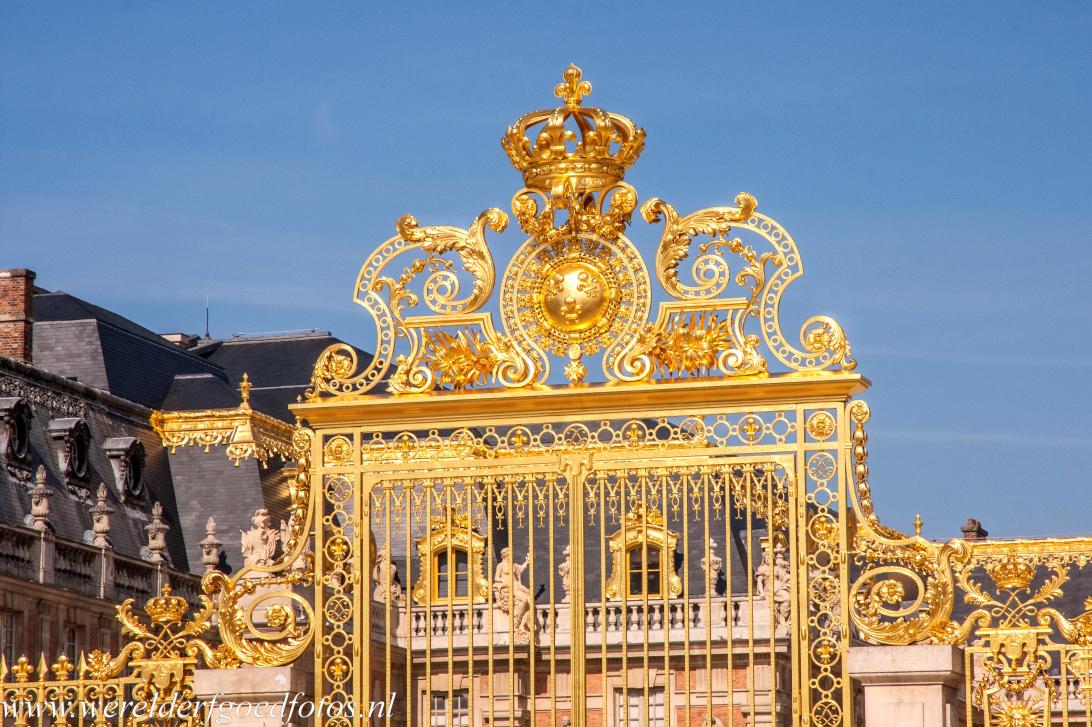
The Palace of Versailles is one of the most famous palaces in the world. The palace was built as a hunting lodge. It was later expanded into a royal palace by King Louis XIV, also known as the 'Sun King'. Until the French Revolution in 1789, the palace was a royal residence and the home of many kings and queens of France. The Palace and Park of Versailles were inscribed on the UNESCO World Heritage List in 1979.

The Palace of Versailles is one of the most famous palaces in the world. The palace was built as a hunting lodge. It was later expanded into a royal palace by King Louis XIV, also known as the 'Sun King'. Until the French Revolution in 1789, the palace was a royal residence and the home of many kings and queens of France. The Palace and Park of Versailles were inscribed on the UNESCO World Heritage List in 1979.
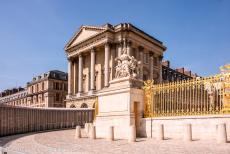
Palace and Park of Versailles: The Palace of Versailles was built as a hunting lodge by King Louis XIII in 1624. His son, Louis XIV, the Sun King, had it expanded into one of the largest palaces in the world and moved the court and government of France to Versailles in 1682. The Courtyard of Honour, the Cour d'Honneur, is situated in front of the Royal Gates. The Royal Courtyard and the Marble Courtyard are situated behind the Royal Gates.
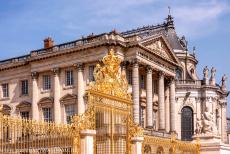
The Palace of Versailles is located behind the gold plated wrought iron Portes Royales, the Royal Gates. The gates separate the Marble Courtyard from the Cour d'Honneur, the Court of Honour. The palace became a museum in the 19th century. The text 'A toutes les Gloires de France' was engraved on the two protruding façades of the palace; the meaning of the text: 'all the glorious moments of France'. To the right lies the Royal Chapel of the palace.
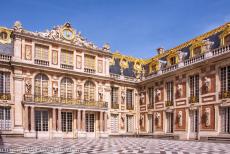
Palace and Park of Versailles: The Cour de Marbre, the Marble Courtyard, in front of the palace is the original inner courtyard of the former hunting lodge. It was created during the reign of the French King Louis XIII in 1623. The Marble Courtyard is paved with black and white marble tiles in a geometric pattern. The façade of the original hunting lodge is preserved in the centre of the main entrance façade of the present palace.
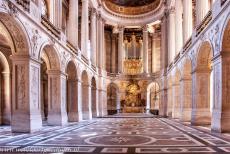
Palace of Versailles: The interior of the Baroque Royal Chapel of King Louis XIV. The construction of the two-level palatine chapel was completed in 1710. The organ is decorated with a fine relief depicting the biblical King David. The paintings on the vaulted ceiling depict several scenes from the Bible. In the Royal Chapel, King Louis XVI of France married the Austrian Archduchess Marie-Antoinette in 1770; they were the last royal couple who lived in the Palace of Versailles.
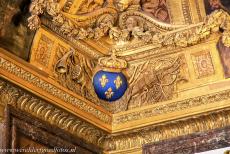
The Palace of Versailles is lavishly decorated, among the decorations the coat of arms of the Kingdom of France (Moderne), the three fleurs-de-lys. A fleur-de-lys is a stylised lily, a symbol of France. After the Franco-Prussian War (19 July 1870 - 10 May 1871) and the defeat of the French aggressors, the palace was the headquarters of the German Army until March 1871. On the 18th January 1871, the German Empire was proclaimed in the Hall of Mirrors.
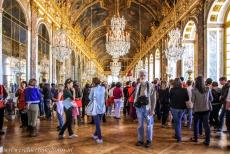
Palace and Park of Versailles: The most famous room at Versailles is the Hall of Mirrors. In the 17th century, mirrors were among the most expensive items to possess. The Hall of Mirrors was built between 1678 and 1686 and was used daily by King Louis XIV when he walked from his private apartments to the Royal Chapel. The Treaty of Versailles, the peace settlement after World War I, was signed in the Hall of Mirrors in 1919.
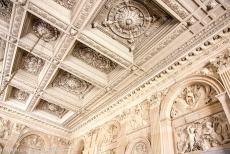
Palace and Park of Versailles: All the ceilings in the Palace of Versailles are richly decorated. The palace was the place where the Treaty of Versailles was signed after WWI. It was considered the most suitable location because of its size. The huge palace could accommodate the hundreds of dignitaries who were involved in the peace process and the final signing ceremony in the Hall of Mirrors, the most famous room in the palace.
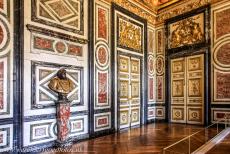
The Palace of Versailles was built to impress. It is richly embellished with coloured marble. The marble decorations are still original, but most of the original furniture was scattered during the French Revolution. Some royal furnishings returned to the palace in the 1960s. Versailles is the most visited palace in France. The Palace of Versailles is one of the most famous palaces in the world. The palace is situated about 20-25 km west of Paris.
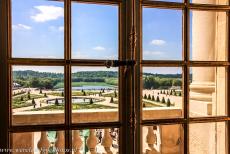
Palace and Park of Versailles: The famous French Gardens of Versailles viewed from the Palace of Versailles. This is what King Louis XIV, the Sun King, saw when he looked out of his window. The Palace and Park of Versailles has greatly influenced the design of other palaces and gardens in Europe. Many palaces and gardens were modelled after the palace and gardens of Versailles, among them the Palace of Schönbrunn in Vienna and Drottningholm Palace in Stockholm.
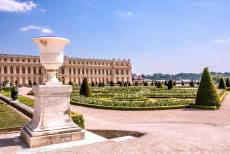
Palace and Park of Versailles: The Palace of Versailles viewed from the French gardens. The Park of Versailles is one the most renowned parks in the world. The park is covered with landscaped woodland areas and a number of classic French gardens, designed by the French landscape and garden architect André Le Nôtre, the principal gardener of King Louis XIV of France, also known as the Sun King. The Park of Versailles covers about 800 hectares of land.
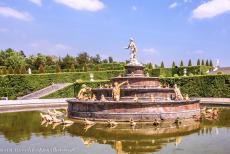
Palace and Park of Versailles: The Latona Fountain is surrounded by classic French gardens. The Latona Fountain was inspired by the Metamorphoses of Ovide. The fountain illustrates the myth of the goddess Latona, protecting her children Apollo and Diana. The marble statue at the top of the fountain is surrounded by gilded sculptures of frogs and six peasants, half-human, half-frog. The fountain operates three times a week during the high season.
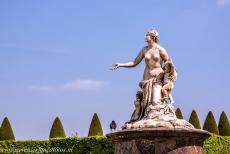
Palace and Park of Versailles: The centrepiece of the famous Latona Fountain. The white marble statue group depicts Latona, the Roman goddess of motherhood, with her twin children Apollo and Diana. The statue of the goddess Latona faces the Grand Canal, the largest artificial water feature in the Park of Versailles. The Latona Fountain was created between 1667 and 1670. The fountain was built according to the wishes of King Louis XIV, the Sun King.
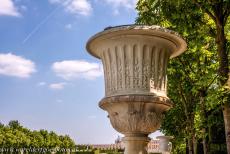
Palace and Park of Versailles: The Park of Versailles covers approximately 800 hectares. The huge park is completely surrounded by a wall more than 40 km long. The park was designed by the master gardener André Le Nôtre from 1661 to 1700. The park is decorated with fountains, follies and statues. The Park of Versailles is considered the model of all French gardens around the world. In the late-16th century, the Baroque garden style originated in Italy and spread to France, where it became known as the French garden style.
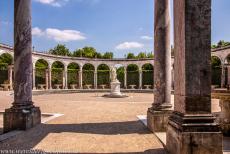
Palace and Park of Versailles: La Colonnade Grove is a tiny circular garden. In the centre stands a white marble sculptural group depicting the Abduction of Persephone, the Greek goddess of spring and the queen of the underworld. La Colonnade Grove was created in 1685; the arches are made of Italian Carrara white marble and supported by square and round Ionic columns of purple and deep blue marble, and marble from the Languedoc region in France.
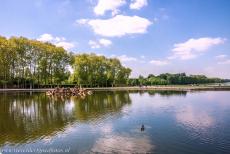
Palace and Park of Versailles: The Bassin d'Apollon, the Apollon Pond, and the Apollo Fountain. The artificial pond already existed since the reign of Louis XIII and was known as the Swan Lake. King Louis XIV added the gilded fountain in 1670. The fountain is based on the myth of Apollo, the Greek sun god. King Louis XIV associated himself with the Greek sun god. The centrepiece of the fountain depicts the god Apollo rising from the sea in a four-horse chariot.
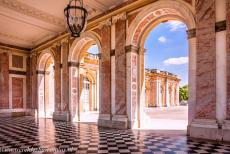
Palace and Park of Versailles: The Grand Trianon is a small pink marble palace in the gardens of Versailles. The Grand Trianon was built in 1687. It is considered the most beautiful building in the gardens of Versailles. After World War One, the Treaty of Trianon was signed at the Grand Trianon. The Treaty of Trianon was the peace agreement between the Allies of the First World War and the Kingdom of Hungary. The treaty regulated the status of an independent Hungarian state and the final borders of Hungary were defined.
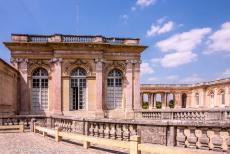
Palace and Park of Versailles: The Grand Trianon is a palace situated in the Park of Versailles. It is surrounded by Baroque French gardens planted with tuberoses, orange trees, perennials and green shrubs. The Grand Trianon was used by King Louis XIV to escape the formality of the royal court life. Napoleon Bonaparte also stayed at the Grand Trianon on many occasions. The French President de Gaulle had it restored and used the palace as a presidential residence.
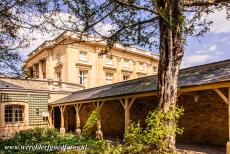
Palace and Park of Versailles: Le Petit Trianon is a small palace just a short walk from the Grand Trianon in the Park of Versailles. Le Petit Trianon was built under Louis XV for his mistress and confidante Madame de Pompadour. His grandson King Louis XVI gave it to his Queen consort Marie-Antoinette in In 1774; it was her favourite palace. The small palace was used by Marie-Antoinette to escape the formality of the royal court life at Versailles; it was here that she heard that the French Revolution had reached the outskirts of Versailles.
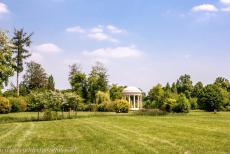
Palace and Park of Versailles: The Temple de l'Amour, the Temple of Love. The temple is one of the follies in the park, situated near the château Le Petit Trianon. Le Petit Trianon overlooks the garden with the Temple of Love. Queen Marie-Antoinette of France ordered to design and build the small Neoclassical Temple of Love. The Palace and Park of Versailles gained the status as a UNESCO World Heritage in 1979.
